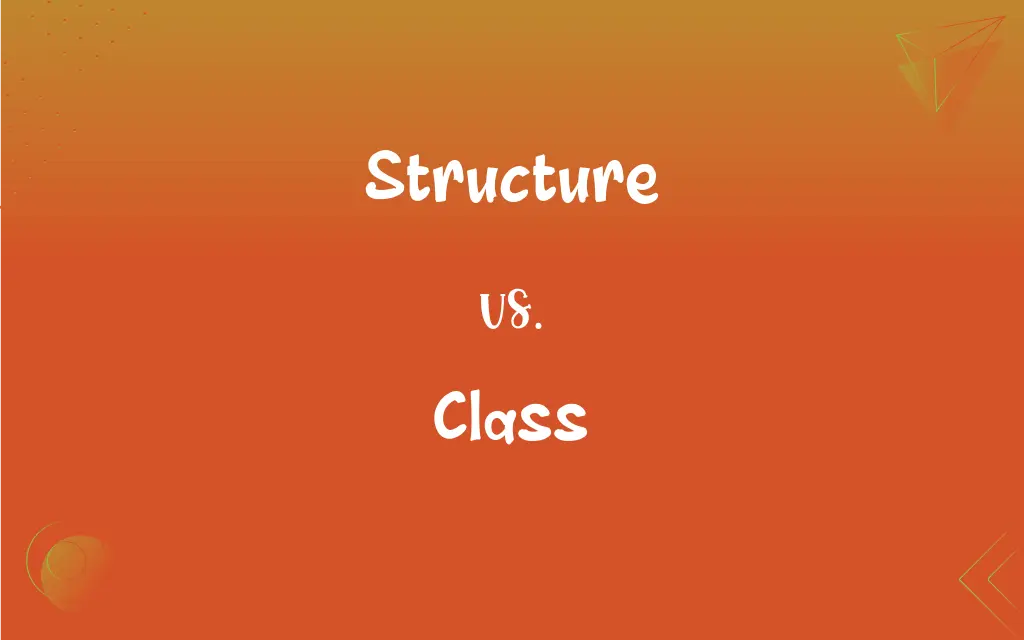Structure vs. Class: What's the Difference?
Edited by Aimie Carlson || By Harlon Moss || Published on February 3, 2024
A structure is a user-defined data type grouping variables of different types, with default public access; a class is a blueprint for objects with private access by default and supports encapsulation, inheritance, and polymorphism.

Key Differences
A structure, commonly used in languages like C, is a user-defined data type that allows grouping variables of different types. Structures are primarily used to represent a record. In contrast, a class, a fundamental concept in object-oriented programming languages like C++ and Java, is also a user-defined data type but is used to encapsulate data and functions together, representing a real-world entity.
In structures, members are public by default, meaning they can be accessed directly using the dot operator. However, in classes, members are private by default, which restricts direct access and enforces encapsulation, a core principle of object-oriented programming. This difference in access specifiers underscores a fundamental distinction in how data is managed and accessed within structures versus classes.
Structures are typically used when you need a simple grouping of data without requiring the advanced features of object-oriented programming. Classes, however, provide additional features like inheritance and polymorphism, which allow for more complex and organized code, essential in large-scale software development.
Structures in C++ have the capability to contain functions and access specifiers similar to classes, they are still generally used for simpler data storage compared to classes. Classes, with their ability to support constructors and destructors, offer more control over how objects are initialized and destroyed, providing a more robust framework for managing resources.
The concept of inheritance, where a class can inherit properties and behaviors from another class, is not applicable in structures. Classes, on the other hand, use inheritance to create a hierarchy of classes that can share, override, or extend functionality, making it a powerful tool for reducing redundancy and enhancing code reusability.
ADVERTISEMENT
Comparison Chart
Default Access Specifier
Members are public by default.
Members are private by default.
Primary Usage
Simple grouping of data.
Encapsulation of data and methods.
Support for OOP Features
Limited; no support for inheritance or polymorphism.
Supports encapsulation, inheritance, and polymorphism.
Constructors/Destructors
Does not support constructors and destructors.
Supports constructors and destructors.
Typical Use in Programming
Used for data structures in procedural programming.
Used in object-oriented programming.
ADVERTISEMENT
Structure and Class Definitions
Structure
A structure is a collection of variables of different types under a single name.
The structure 'Person' contained name, age, and address.
Class
Classes support the principles of object-oriented programming.
She created a class 'Animal' that other classes like 'Dog' could inherit from.
Structure
In structures, data members are public by default.
Within the structure, the member 'salary' was accessible directly.
Class
Classes enable polymorphism, allowing methods to be overridden.
The method 'draw' was overridden in each subclass of the class 'Shape'.
Structure
Structures in C are primarily used for data storage.
The program defined a structure to hold the geometric coordinates.
Class
A class is a blueprint for objects, encapsulating data and functions.
The class 'Car' defined properties like speed and methods like accelerate.
Structure
Structures are used to represent a record in programming.
He used a structure to store each employee's data efficiently.
Class
Members of a class are private by default, ensuring encapsulation.
In the class 'Account', the balance was kept private to protect the data.
Structure
Structures can contain both data and functions in C++.
He added a function to the structure to calculate the total cost.
Class
Classes can have constructors and destructors for object management.
The class 'Database' used a constructor to establish a connection.
Structure
(computing) Several pieces of data treated as a unit.
This structure contains both date and timezone information.
Structure
(logic) A set along with a collection of finitary functions and relations.
FAQs
What is a structure in programming?
A structure is a user-defined data type for grouping different data types.
What is the primary use of a structure?
Structures are used for simpler data storage and representing records.
What is a class in programming?
A class is a blueprint for creating objects, encapsulating data and methods.
Can classes be inherited?
Yes, classes support inheritance in object-oriented programming.
Do structures support inheritance?
No, structures do not support inheritance.
Are class members public or private by default?
In classes, members are private by default.
Are structure members public or private by default?
In structures, members are public by default.
Can structures contain functions?
Yes, structures in C++ can contain functions.
Do classes support constructors and destructors?
Yes, classes support constructors and destructors for object management.
Can a structure inherit another structure?
No, structures do not support inheritance.
Can a class contain only methods?
Yes, a class can be defined with only methods.
Are classes more suitable for object-oriented programming?
Yes, classes are fundamental to object-oriented programming.
Is encapsulation a feature of structures?
No, encapsulation is a feature more associated with classes.
Do classes support polymorphism?
Yes, classes support polymorphism, allowing method overriding.
Can a class contain only private members?
Yes, a class can have all members as private.
Are structures less complex than classes?
Generally, structures are simpler and used for less complex data grouping.
Do structures support method overriding?
No, structures do not support method overriding.
Can structures be used in C++?
Yes, structures can be used in C++ with added functionality.
Can structures and classes be used together?
Yes, in languages like C++, structures and classes can be used together.
Can a class implement an interface?
Yes, classes can implement interfaces in languages like Java.
About Author
Written by
Harlon MossHarlon is a seasoned quality moderator and accomplished content writer for Difference Wiki. An alumnus of the prestigious University of California, he earned his degree in Computer Science. Leveraging his academic background, Harlon brings a meticulous and informed perspective to his work, ensuring content accuracy and excellence.
Edited by
Aimie CarlsonAimie Carlson, holding a master's degree in English literature, is a fervent English language enthusiast. She lends her writing talents to Difference Wiki, a prominent website that specializes in comparisons, offering readers insightful analyses that both captivate and inform.




































































